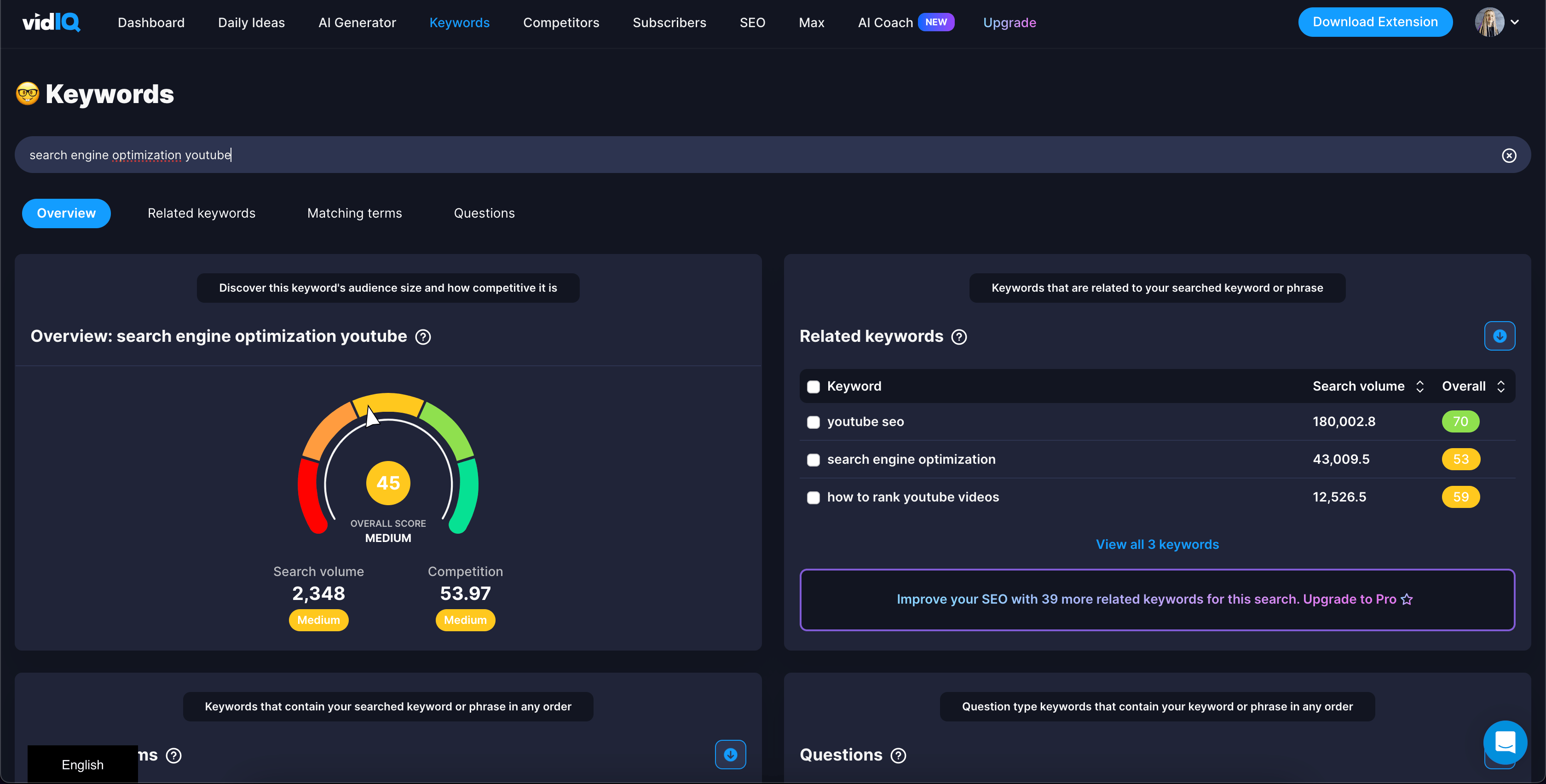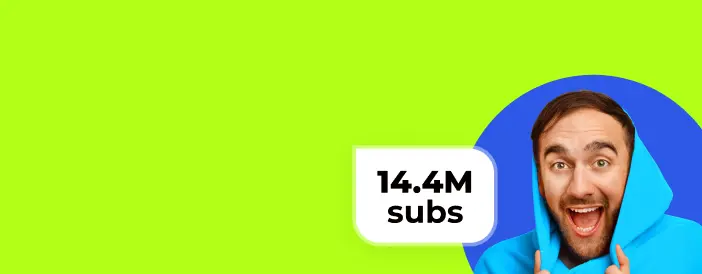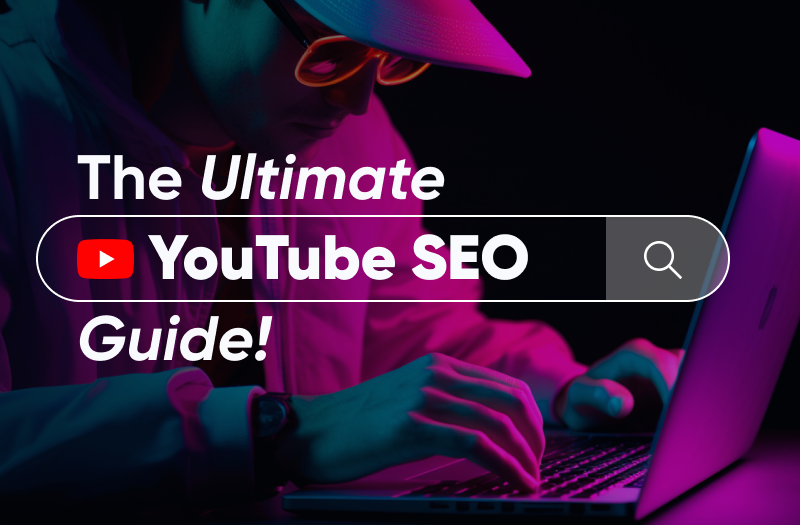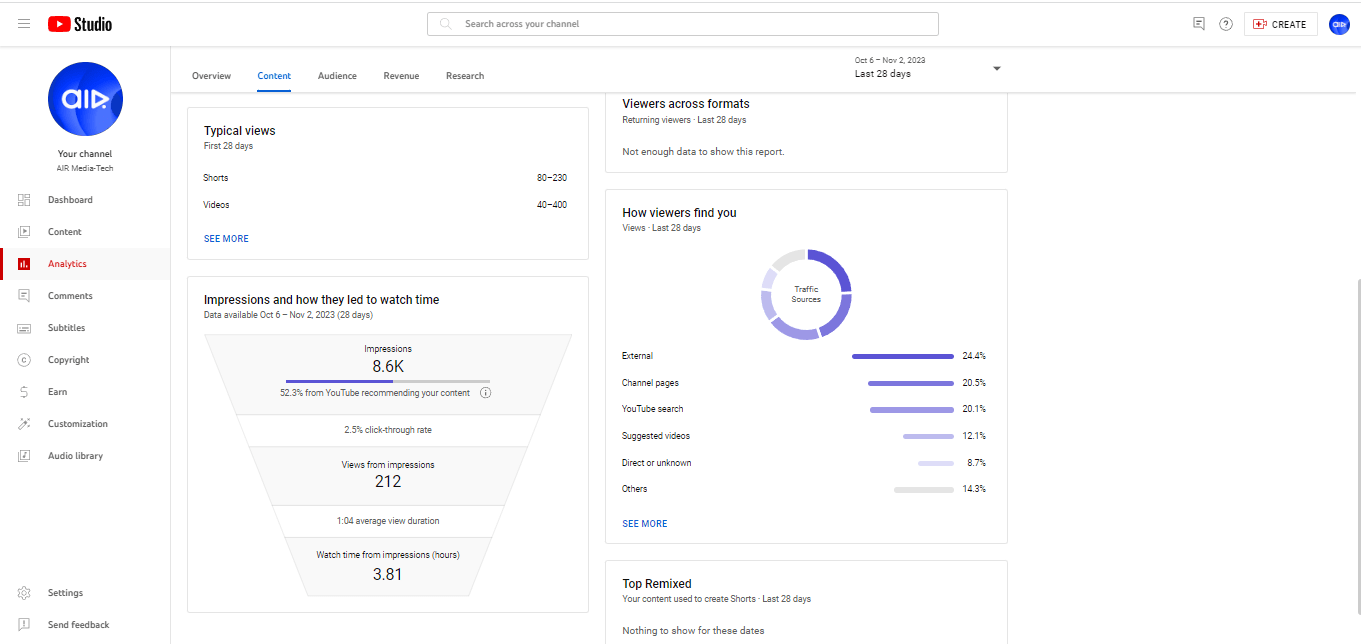
Are you wondering how to climb the YouTube ladder and get your videos to rank? Well, you're in the right place! This guide is all about video SEO and how it can give your YouTube content a mega boost!
What is YouTube SEO?
YouTube SEO involves optimizing your videos and channel to enhance their visibility and improve their ranking on YouTube's search and recommendations. Essentially, this is your key to standing out among countless hours of content on the platform.
So, why bother with all this YouTube optimization stuff like descriptions, titles, and tags? Here's why:
- Firstly, optimization is your ticket to the YouTube search results. Make it right, and your videos pop up when someone searches on YouTube.
- Secondly, it's a game-changer for your SEO ranking - the better your optimization, the higher your video ranks in a YouTube search.
- And lastly, it's the secret sauce that makes viewers pick your video over others.
AIR Media-Tech has helped thousands of content creators boost their YouTube channels through SEO optimization. Reach out to us for custom support.
How Does Search Engine Optimization Work for YouTube?
YouTube SEO is like a puzzle with many pieces, all working together to make sure your videos get in front of the right audience. It focuses on both on-page and off-page elements:
- On-page elements: Titles, descriptions, tags, thumbnails, captions, and keywords that you control directly.
- Off-page factors: Viewer behavior, such as watch time, likes, shares, and comments.
YouTube uses a combination of algorithms and user behavior to decide which videos appear at the top of search results and get recommended in the “Up Next” section. Let’s break down how it works:
- Keywords: The words you use in your video title, description, and tags help YouTube’s algorithm understand what your video is about.
- Engagement Metrics: Likes, comments, shares, and even dislikes are signals that YouTube uses to determine if people are interacting with your content. The more engaged your audience is, the more likely YouTube is to push your video to others.
- Watch Time: The longer people watch your video, the more valuable YouTube considers it. If you can keep viewers glued to their screens for the entirety of your video, you’re on the right track.
- Click-Through Rate (CTR): This is all about your title and thumbnail working together to get viewers to click. A high CTR means your video is compelling and appealing, making it more likely that YouTube will recommend it to others.
Results of YouTube SEO May Impress You
When you get YouTube SEO right, the results can be like rocket fuel for your channel. Here’s what you can expect when your SEO game is on point:
- Explosive Growth in Views: SEO optimization can make your videos a lot more visible. A video that was gathering dust with 100 views can suddenly jump to thousands or even hundreds of thousands of views, thanks to better placement in search and recommendations.
- Steady Stream of New Subscribers: More visibility means more people discovering your channel. You’ll start to notice a steady flow of subscribers who found your content through search or recommendation, turning casual viewers into loyal fans.
- Increased Watch Time: A well-optimized video isn’t just about the clicks—it’s about keeping viewers around. Better ranking means more eyes on your content, which leads to higher watch time. And as you know, watch time is the currency that YouTube’s algorithm loves the most.
- Better Ad Revenue: More views + more watch time = more opportunities for YouTube to place ads on your videos. Creators who focus on SEO often see a significant boost in ad revenue, making all that keyword research and optimization effort well worth it.
- Greater Authority in Your Niche: When your videos consistently appear at the top of search results, you become the go-to channel in your niche. This kind of authority can attract brand deals, sponsorships, and other monetization opportunities.
In short, good SEO doesn’t just help your videos rank better—it transforms your entire channel, turning it into a magnet for views, engagement, and revenue.
How to Do SEO for YouTube Videos?
Now that we've nailed the 'why,' let's dive into the 'how.' It's time to level up your YouTube video optimization and get you that higher ranking you deserve!
Create Keywords First for Your Videos
Before hitting record, think about the keywords your audience might use to find your content. Use tools like VidIQ or Google Trends to find keywords that are popular but not overly competitive. Focus on:
- Primary Keywords: The main phrase you want your video to rank for.
- Secondary Keywords: Related terms and phrases that support your primary keyword.
These keywords will become the backbone of your title, description, tags, and even the script for your video.
Add Good Video Titles and Control Their CTR
Your title is the first impression viewers get, so make it count! A catchy title that contains your primary keyword can do wonders for your click-through rate (CTR):
- Keep It Concise: Aim for 60-70 characters, so it doesn’t get cut off in search results.
- Create Curiosity: Use numbers, questions, or power words like “best,” “ultimate,” or “how-to” to grab attention.
- Promise Value: Show viewers exactly what they’ll get, whether it’s a solution, a tutorial, or something entertaining.
Remember, a good title and thumbnail combo is like peanut butter and jelly—better together!
Regularly Refresh Old Video Content
Don’t let your older videos gather digital dust! Refresh them to keep them relevant:
- Update Descriptions and Tags: Add new keywords or tweak your description to reflect current trends.
- Change the Thumbnail: A fresh, eye-catching thumbnail can breathe new life into old content.
- Add End Screens: Direct viewers to more of your recent content, keeping them on your channel longer.
This can give your older videos a second wind in the algorithm, bringing in new views and boosting overall channel engagement.
Write SEO-Optimized Descriptions
Your video description is where you can go into detail about what your video is about:
- Lead with Keywords: Include your primary keyword in the first 150 characters.
- Add a Call-to-Action (CTA): Encourage viewers to subscribe, like, or check out your other videos.
- Include Key Details: Add timestamps, links to related content, and your social media handles.
YouTube ranks videos based on relevance, so a better description improves your video's search performance. The more related your title is to a viewer's search, the higher its chance of being shown. Tools like VidIQ can help you find the best YouTube keywords for your video.
Quick tip:YouTube lets you use up to 100 characters for your title, but shorter is sweeter. Aim for 60-70 characters to make sure your full title displays on all devices. Anything longer, and it'll get cut off. Keep it concise and catchy!

Use VidIQ tool to find relevant keywords for your YouTube Channel.
Add Tags to Your Videos
Hashtags are like labels on YouTube. Clicking on a hashtag brings up all videos with the same tag, making it easier for viewers to find your content. So, pick hashtags that match your video's keywords! Use a mix of broad and specific tags:
- Primary Keyword Tags: Focus on the main topic of your video.
- Niche Tags: Include tags related to your industry or niche.
- Competitor Tags: See what tags popular videos in your niche are using and borrow a few.
Quick tip: Toss in at least 3 hashtags in your video description. It helps YouTube get what your video is about, you know? But, don't go crazy with it! Keep it under 10 hashtags for the best vibes.
Create Transcriptions and Captions for the Videos
Adding captions and transcripts isn’t just about accessibility—it’s also great for SEO. YouTube’s algorithm can crawl through your captions to better understand your content.
- Automatic Captions: YouTube generates them, but always review for accuracy.
- Custom Transcriptions: Upload your own for higher accuracy and to include your keywords naturally.
Add Timestamps to Your Videos
Timestamps break down your video into sections, making it easier for viewers to find what they’re looking for:
- Highlight Key Points: Timecode important segments like intros, tips, and conclusions.
- Improve Watch Time: Viewers are more likely to stay if they can skip directly to what interests them.
Timestamps can also appear in Google search results, giving your video more visibility.
Analyze Your Competitors
It’s always smart to know what your competition is up to.
- Watch Similar Videos: Look for trends, keywords, and topics that are gaining traction.
- Study Their SEO Tactics: Note how they structure their titles, descriptions, and thumbnails.
- Differentiate Your Content: Learn from their strengths but make sure your content offers a unique perspective.

Make Longer Videos
While short videos are great for quick engagement, long-form content often ranks better due to more watch time.
- Aim for 10+ Minutes: It allows for more in-depth discussion and gives YouTube more room to insert ads.
- Keep It Engaging: Use storytelling, visuals, and pace changes to keep viewers hooked.
Longer videos help with viewer retention, which is a strong signal to YouTube’s algorithm.
Create Custom Thumbnails for Your Videos
A custom thumbnail is like your video’s cover art—it’s got to grab attention.
- Bright Colors and Bold Text: Make it stand out against YouTube’s white background.
- Use Faces: Thumbnails with expressive faces tend to get more clicks.
- Keep It Clean: Avoid clutter—focus on one main image with a catchy phrase or title overlay.
Good thumbnails can boost your CTR, making it easier for your video to rank higher.
Quick tip: Get Inspiration from Other YouTube Videos! Watch creators in your niche and you'll notice what emotional triggers and keywords they use in their videos.
Use Keywords in Your YouTube Video
Don’t just focus on written SEO—speak those keywords in your video too! YouTube’s AI listens to your video’s audio, so saying your keywords naturally can improve relevance.
Add Subtitles for Several Languages
Subtitles can broaden your audience and make your content accessible worldwide:
- Reach New Markets: Offering subtitles in different languages makes your video relevant to non-English speakers.
- Boost Engagement: Subtitles can help viewers who are watching in noisy environments stay engaged with your content.
It’s a win-win for expanding your reach and inclusivity.
Distribute Your Videos to Different Platforms and Websites
Why wait for people to find your video? Share it across all your platforms:
- Post on Social Media: Share your videos on Instagram, Facebook, X, or LinkedIn.
- Embed in Blog Posts: If you have a website, embedding your video can drive traffic from your site to YouTube.
- Collaborate with Influencers: Partner with influencers to promote your video on their platforms.
The more places your video appears, the more chances it has to gain views and engagement.
Take Advantage of End Screens and YouTube Cards
Keep viewers on your channel by guiding them to more of your content:
- End Screens: Use them to recommend other videos or playlists at the end of your video.
- YouTube Cards: Add them during key moments to promote related content.
It’s a great way to boost watch time and keep viewers exploring your channel.
Place Hashtags in Your Description
Hashtags help your videos surface in searches for trending topics:
- Use Niche Hashtags: Make them relevant to your content and community.
- Use Up to 10: More than that can be counterproductive.
Use Pinned Comments
Pin a comment with a CTA or additional info at the top of your video’s comments section. It’s an easy way to direct viewers to another video, your website, or to encourage engagement.
Create Playlists for Related Videos
Group related videos into playlists to increase session watch time. When viewers finish one video, they’re more likely to keep watching if they’re in a playlist.
Collaborate with Other YouTubers and Influencers
Collaborating with others in your niche exposes you to a new audience:
- Do Joint Videos: Create content together that appeals to both of your audiences.
- Shout-Outs and Mentions: Even a simple shout-out can bring new eyes to your channel.
It’s a great way to build community and expand your reach.
Create Unique Channel Art and Logo
Your channel art and logo are the visual identity of your brand, so make them memorable:
- Channel Art: Use it to showcase your brand personality, upload schedule, or social media handles.
- Logo: Make it simple but recognizable. Think about how it looks as a small icon next to your videos.
A professional-looking channel gives off a great first impression and can turn curious viewers into subscribers. It’s like dressing your channel in its best outfit before the big party!
SEO Metrics in YouTube Analytics to Pay Attention To
To rank your YouTube videos effectively, you need to know which metrics matter most. Here are some key YouTube Analytics metrics that will give you deep insights into your content’s performance:
- Watch Time: This is the total time viewers spend watching your videos. The more watch time, the better YouTube ranks your content.
- Average View Duration: This metric tells you how long viewers stay on your video. A longer average means you’re keeping your audience engaged!
- Click-Through Rate (CTR): This measures how often people click on your video after seeing it in their feed. A higher CTR means your thumbnails and titles are doing their job.
- Audience Retention: Shows where viewers drop off in your video. Use this data to improve your content and keep people watching longer.
- Impressions and Reach: These metrics reveal how many people see your video thumbnail and how often it’s clicked. They’re crucial for understanding your video’s visibility.
By tracking these metrics, you can spot patterns, identify areas for improvement, and optimize your videos for better performance.
AI SEO Optimization: Is It Really Helpful?
AI is no longer just a buzzword; it’s a game-changer in SEO. But is it worth the hype for YouTube?
AI for Keyword Research: Tools like ChatGPT and AI-driven keyword finders can help identify trending keywords faster than ever. They analyze tons of data to find hidden keyword gems you might miss manually.
AI-Powered Video Descriptions: AI can suggest optimized descriptions, titles, and tags based on your video content, helping you craft SEO-friendly copy without breaking a sweat.
Thumbnails and Video Ideas: AI design tools (think Canva’s AI) can help generate thumbnail designs, while AI can also suggest video topics based on what’s trending in your niche.
Does It Work? The short answer is yes—but it’s not a magic solution. While AI can streamline a lot of the grunt work in SEO, it’s still important to use your creative and analytical skills to make sure your content resonates with your audience.
SEO Tools That Will Help You in Video Optimization
To dominate YouTube, you need the right tools in your arsenal. Here’s a roundup of some must-have tools for YouTube SEO:
VidIQ, TubeBuddy
These two tools are like Swiss army knives for YouTube creators, offering a range of features:
- Keyword Research: They help you find high-ranking keywords that match your content and suggest tags to boost your video’s reach.
- Competitor Analysis: You can peek into what keywords your competitors are ranking for and adjust your strategy accordingly.
- SEO Scores: Get a quick analysis of how optimized your video is and where you can improve.
- Video Tags: Both tools recommend tags based on trending topics, giving your videos an edge in the algorithm.
VidIQ and TubeBuddy are perfect for creators who want to take the guesswork out of SEO and get a deeper understanding of what makes videos rank.
Ahrefs, Semrush, Serpstat
While these tools are traditionally used for website SEO, they offer powerful insights for YouTube creators too:
- Backlink Analysis: They help you find opportunities for link-building to your video content, which can boost visibility on Google as well as YouTube.
- Keyword Difficulty Scores: Get a sense of how hard it will be to rank for certain keywords, helping you prioritize your focus.
- Content Gap Analysis: These tools can show you which keywords your competitors rank for that you’re missing, so you can create videos that fill the gap.
If you’re looking to integrate your YouTube SEO efforts with a broader content strategy, these tools are top-notch.
YouTube Analytics
This built-in tool is often overlooked, but it’s packed with useful data to improve your SEO game:
- Traffic Sources: See where your views are coming from—search, suggested videos, external links, or playlists.
- Search Terms: Find out what keywords are driving traffic to your videos, so you can double down on those.
- Demographics: Understand your audience's age, gender, and location to tailor your content.
With YouTube Analytics, you can track how well your SEO efforts are working and adjust your strategy based on hard data.
Google Trends
Google Trends is the ultimate free tool for tracking what’s hot in your niche:
- Trending Topics: It lets you explore trending searches and topics to ensure your content is timely.
- Compare Keywords: See how multiple keywords stack up against each other and choose the best one for your video.
- Seasonal Trends: Understand when interest in a particular topic spikes throughout the year and time your content accordingly.
For creators looking to stay ahead of the curve, Google Trends is a goldmine.
Keywords Everywhere
This browser extension gives you quick keyword data right on your screen:
- Search Volume: See how often people search for a keyword on Google and YouTube.
- Cost-per-Click (CPC): If you’re running ads, you can see how competitive the keywords are.
- Related Keywords: Get a list of similar keywords to use in your tags or description.
Keywords Everywhere is a great lightweight tool for quick keyword checks without needing a deep dive into analytics.
Canva, Midjourney
Who says SEO is all about text? Visual appeal is a huge part of your YouTube success, and Canva and Midjourney are here to help:
- Canva: This design tool is perfect for creating eye-catching thumbnails, banners, and end screens. Use it to design:
- Thumbnails: Canva offers templates tailored for YouTube, allowing you to create bright, engaging thumbnails that pop.
- Channel Art: Make your channel look professional with banners that communicate your brand’s vibe.
- Social Media Graphics: Promote your videos on Instagram, Facebook, and other platforms with consistent, branded visuals.
- Midjourney: An AI-driven tool that helps generate stunning artwork. Think of it as a creative partner:
- Thumbnails and Art: Use AI-generated elements to give your thumbnails a unique look.
- Video Concepts: Stuck for visual ideas? Midjourney can spark your creativity with fresh concepts you might not have thought of.
Combining Canva’s user-friendly design features with Midjourney’s AI magic makes for a winning duo, giving your videos the visual punch they need to attract more clicks.
Truth Wins on YouTube
Indeed, catchy titles and descriptions have the power to pique viewers' interest. However, YouTube promotes authenticity over sensationalism. It doesn't take kindly to clickbait content, including misleading video titles. YouTube's support page clearly indicates its stance against "deceptive metadata or thumbnails" that aim to trick viewers into watching a video using false titles, thumbnails, or descriptions.
Moreover, when crafting your YouTube video titles, always remember to respect the community guidelines. Avoid using offensive language, promoting hate speech, or spreading harmful misinformation. Keep it real, keep it respectful, and above all, keep it engaging for your audience.
There you go! These YouTube SEO tips are your ticket to ramp up your visibility. Remember, when it's time to level up your game, AIR Media Tech is just around the corner. We're eager to lend a hand in everything - be it audience expansion, revenue multiplication, or sorting out those strikes. Drop us a line and let us help you grow!






